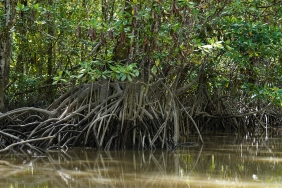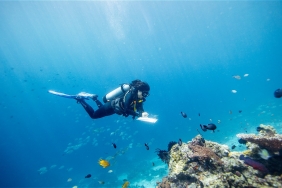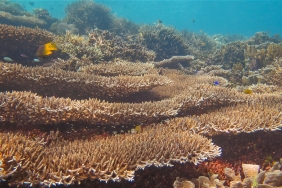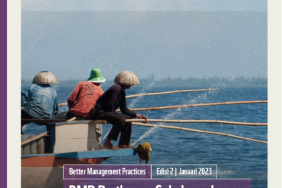FISHING LOG BOOK: TO CENSUS OUR FISH STOCK
by Maskur Tamanyira
How is our fish stock condition? How many tuna fish are there in the sea? How many fish have we taken? Those questions rarely comes to our mind because all this time, we assume that the sea is a vast place of fish and will never run out of fish. However, the world’s fishery experts have different opinion. Through a lot of research carried out in all regions in the world, they argue that the world’s fish stock is heading to the brink of extinction by this mid-century. The researchers further said that about 50% of global fish stocks are exploited.
Their research explains that the world’s fishery will collapse by this mid-century if no improvement is made in the world’s fishery management system. Codfish fishery was collapsed in the North Atlantic Ocean, followed by a moratorium proposal regarding Blue fin Tuna’s withdrawal in Mediterranean Sea were real examples of how the vast sea is not necessarily contain abundant fish stock.
We were often taught that the sea has unlimited resources or is renewable. In fact we often forget that the resources availability and renewal can happen on one important condition; a responsible and ongoing management. Massive exploitation of our ocean is also caused by wrong perception about the vast sea and the lack of presentable data collection about the exploited fish stock. As a result, our fish withdrawal policy does not rely on factual data. In 2006, the world was shocked by a research result published by world’s scientists regarding the fact that fish would run out and its biodiversity had decreased up to 29% since 1960. This is a negative impact of fishing activity that does not comply with environmental rules and have a tendency to damage the environment.
So how do the policies can be made in line with the actual condition? Politicians and scientists would agree that census and data collection are the important keys in fishery industry because calculating the fish population directly in the open sea is not possible, not even with satellite technology. With integrated and accessible data collection, all stakeholders can see clearly the fish withdrawal trend from year to year, the kind of fish caught, location, tools for catching, etc. The data statistic will certainly “speak” a lot about our fishery.
Unfortunately, in many places in the world including Indonesia, fishery data collection is not yet integrated. Great and modern fishermen make records for their own benefit, while traditional fishermen are obstructed by illiteracy and the lack of knowledge, whereas one of the relevant data collections is the use of log book, and positioning one observer in the spots of fishing activity as an effort to collect data and supervise fishing activity.
Recognizing the importance of using the log book, relevant Directorate in the Ministry of Maritime and Fisheries Affairs is trying to amend the current record system by adding details to be recorded, not only the numbers of fish and its species. This link explains the Regulation of Republic of Indonesia Number 45 Year 2009 regarding amendments of Regulation of Republic of Indonesia Number 31 Year 2004 about Fishery (for more details about fishery log book, read the regulations of the Ministry of Maritime and Fisheries Affairs Number: 18/Men/2010) that fishery management is an integrated effort process in collecting information, analysis, planning, consultation, decision making and allocation of fish resources; and its implementation and law enforcement of fishery regulation is a part of fishery management. The regulation clearly and firmly stated that fishery management must be based on relevant data. Fishery data collection strategy should be confirmed as a routine and long-term observation program by the using of log book. Here are some important objectives of the log book:
- Log book as a landing declaration of the captain, or a statement letter about the fish brought to the fishing harbor.
- Fishery log book supports fishery data collection statistic (fishing area, fish species and volume).
- Fishery log book records fishing permission data (fishing tools), vessel registration data (LxBxD; Power), and vessel harbor.
- Support SDI management evaluation and analysis (fishing capacity, fishing efficiency, fishing season related to open and close session, and conservation).
Fishery research expert, Subhat Nurhakim, as quoted here, stated that all this time, assessment process of fish stock in Indonesia is still not effective. One of the causes is the incomplete data that makes the fishery statistic unable to represent the nation’s fishery condition. The same article also stated that if this condition remains, Indonesia will experience a lot of loss, such as economic loss. It happens because there should be income and incentive from the fish species and ecological loss calculation that can also reduce loss due to illegal acts such as theft and smuggling. Subhat reaffirmed to mend the condition. Appropriate and integrated step of recovery is through fishery log book program, by making records of species, origin and size of the fish, including other important details.
contact: Imam Musthofa, Fisheries Project Leader, imusthofa@wwf.or.id
Note:
WWF-Indonesia fisheries program have set up a line of program aiming to achieve sustainable fisheries, which include:
- Introduction and promotion of the Tuna fisheries Ecosystem Based Management (Tuna fishery-EBM) by 2012.
- Composing Better practices of Tuna and Reef Food Fish (RFF) fisheries for fishing and handling, aquaculture, which will also be able to drive the creation of fair business within its business chain of custody by 2013.
- Widening campaign on seafood guideline to consumers (e.g. individual, restaurants, hotels, major retailers) in 5 big cities by 2009.
This achievements and yet also challenges have been recognized by the support of USAID-CTSP, WWF-Netherland, WWF-Denmark, WWF-US, DANIDA (Danish International Development Agency), Packard Foundation, Crown Foundation, AAGE Foundation, Oak Foundation, and Oxfam Novib.





